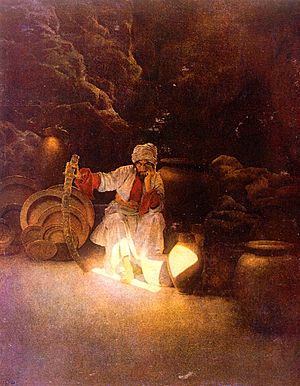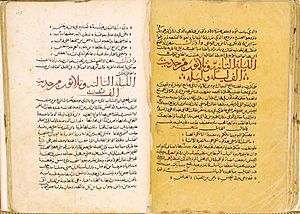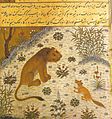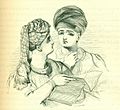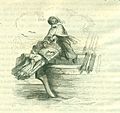One Thousand and One Nights facts for kids
|
Cassim in the cave, by Maxfield Parrish, 1909, from the story "Ali Baba and the Forty Thieves"
|
|
| Author | various |
|---|---|
| Country | Middle East |
| Language | Arabic language |
| Subject | Story |
| Genre | Frame story, Folk tales |
| Set in | Middle Ages |
The Book of One Thousand and One Nights is an old cycle (or group) of stories that mostly come from Arabia and Persia, and a few also from India, Central Asia and China. All these stories were later collected together. There are different layers of the stories:
- Uppermost is the story of Queen Scheherazade who needs to entertain her husband, the Sultan or King Sheheryar, or she would be put to death.
- The next layer is made up of the actual stories, such as Ali Baba and the Forty Thieves, Aladdin and the Magic Lamp, etc.
- In those stories, there is often also a narrator who tells the story.
Although the first known translation into a European language appeared in 1704, it is possible that the Nights began exerting its influence on Western culture much earlier. Christian writers in Medieval Spain translated many works from Arabic, mainly philosophy and mathematics, but also Arab fiction, as is evidenced by Juan Manuel's story collection El Conde Lucanor and Ramón Llull's The Book of Beasts.
Knowledge of the work, direct or indirect, apparently spread beyond Spain. Themes and motifs with parallels in the Nights are found in Chaucer's The Canterbury Tales (in The Squire's Tale the hero travels on a flying brass horse) and Boccaccio's Decameron. Echoes in Giovanni Sercambi's Novelle and Ariosto's Orlando Furioso suggest that the story of Shahriyar and Shahzaman was also known. Evidence also appears to show that the stories had spread to the Balkans and a translation of the Nights into Romanian existed by the 17th century, itself based on a Greek version of the collection.
In Arab culture
There is little evidence that the Nights was particularly treasured in the Arab world. It is rarely mentioned in lists of popular literature and few pre-18th-century manuscripts of the collection exist. Fiction had a low cultural status among Medieval Arabs compared with poetry, and the tales were dismissed as khurafa (improbable fantasies fit only for entertaining women and children). According to Robert Irwin, "Even today, with the exception of certain writers and academics, the Nights is regarded with disdain in the Arabic world. Its stories are regularly denounced as improbable, childish and, above all, badly written".
Timeline
Scholars have assembled a timeline concerning the publication history of The Nights:
- One of the oldest Arabic manuscript fragments from Syria (a few handwritten pages) dating to the early ninth century. Discovered by scholar Nabia Abbott in 1948, it bears the title Kitab Hadith Alf Layla ("The Book of the Tale of the Thousand Nights") and the first few lines of the book in which Dinazad asks Shirazad (Scheherazade) to tell her stories.
- 10th century: Mention of Hezār Afsān in Ibn al-Nadim's "Fihrist" (Catalogue of books) in Baghdad. He attributes a pre-Islamic Sassanian Persian origin to the collection and refers to the frame story of Scheherazade telling stories over a thousand nights to save her life.
- 10th century: Reference to The Thousand Nights, an Arabic translation of the Persian Hezār Afsān ("Thousand Stories"), in Muruj Al-Dhahab (The Meadows of Gold) by Al-Mas'udi.
- 12th century: A document from Cairo refers to a Jewish bookseller lending a copy of The Thousand and One Nights (this is the first appearance of the final form of the title).
- 14th century: Existing Syrian manuscript in the Bibliothèque nationale de France in Paris (contains about 300 tales).
- 1704: Antoine Galland's French translation is the first European version of The Nights. Later volumes were introduced using Galland's name though the stories were written by unknown persons at the behest of the publisher wanting to capitalize on the popularity of the collection.
- c. 1706 – c. 1721: An anonymously translated version in English appears in Europe dubbed the 12-volume "Grub Street" version. This is entitled Arabian Nights' Entertainments—the first known use of the common English title of the work.
- 1768: first Polish translation, 12 volumes. Based, as many European on the French translation.
- 1775: Egyptian version of The Nights called "ZER" (Hermann Zotenberg's Egyptian Recension) with 200 tales (no surviving edition exists).
- 1804–1806, 1825: The Austrian polyglot and orientalist Joseph von Hammer-Purgstall (1774–1856) translates a subsequently lost manuscript into French between 1804 and 1806. His French translation, which was partially abridged and included Galland's "orphan stories", has been lost, but its translation into German that was published in 1825 still survives.
- 1814: Calcutta I, the earliest existing Arabic printed version, is published by the British East India Company. A second volume was released in 1818. Both had 100 tales each.
- 1811: Jonathan Scott (1754–1829), an Englishman who learned Arabic and Persian in India, produces an English translation, mostly based on Galland's French version, supplemented by other sources. Robert Irwin calls it the "first literary translation into English", in contrast to earlier translations from French by "Grub Street hacks".
- Early 19th century: Modern Persian translations of the text are made, variously under the title Alf leile va leile, Hezār-o yek šhab (هزار و یک شب), or, in distorted Arabic, Alf al-leil. Muhammad Baqir Khurasani Buzanjirdi (b.1770) finalized his translation in 1814, patronized by Henry Russell, 2nd Baronet (1783–1852), British Resident in Hyderabad. Three decades later, Abdul Latif Tasuji completed his translation. It was later illustrated by Sani ol Molk (1814–1866) for Mohammad Shah Qajar.
- 1825–1838: The Breslau/Habicht edition is published in Arabic in 8 volumes. Christian Maximilian Habicht (born in Breslau, Kingdom of Prussia, 1775) collaborated with the Tunisian Mordecai ibn al-Najjar to create this edition containing 1001 nights. In addition to the Galland manuscript, they used what they believed to be a Tunisian manuscript, which was later revealed as a forgery by al-Najjar. Using versions of The Nights, tales from Al-Najjar, and other stories from unknown origins Habicht published his version in Arabic and German.
- 1842–1843: Four additional volumes by Habicht.
- 1835: Bulaq version: These two volumes, printed by the Egyptian government, are the oldest printed (by a publishing house) version of The Nights in Arabic by a non-European. It is primarily a reprinting of the ZER text.
- 1839–1842: Calcutta II (4 volumes) is published. It claims to be based on an older Egyptian manuscript (which was never found). This version contains many elements and stories from the Habicht edition.
- 1838: Torrens version in English.
- 1838–1840: Edward William Lane publishes an English translation. Notable for its exclusion of content Lane found immoral and for its anthropological notes on Arab customs by Lane.
- 1882–1884: John Payne publishes an English version translated entirely from Calcutta II, adding some tales from Calcutta I and Breslau.
- 1885–1888: Sir Richard Francis Burton publishes an English translation from several sources (largely the same as Payne).
- 1889–1904: J. C. Mardrus publishes a French version using Bulaq and Calcutta II editions.
- 1973: First Polish translation based on the original language edition, but compressed 12 volumes to 9, by PIW.
- 1984: Muhsin Mahdi publishes an Arabic edition based on the oldest Arabic manuscript surviving (based on the oldest surviving Syrian manuscript currently held in the Bibliothèque Nationale).
- 1986–1987: French translation by Arabist René R. Khawam
- 1990: Husain Haddawy publishes an English translation of Mahdi.
- 2008: New Penguin Classics translation (in three volumes) by Malcolm C. Lyons and Ursula Lyons of the Calcutta II edition
Related pages
Images for kids
-
A page from Kelileh va Demneh dated 1429, from Herat, a Persian version of the original ancient Indian Panchatantra – depicts the manipulative jackal-vizier, Dimna, trying to lead his lion-king into war.
-
Sindbad and the Valley of Diamonds, from the Second Voyage.
-
Harun ar-Rashid, a leading character of the 1001 Nights
See also
 In Spanish: Las mil y una noches para niños
In Spanish: Las mil y una noches para niños


